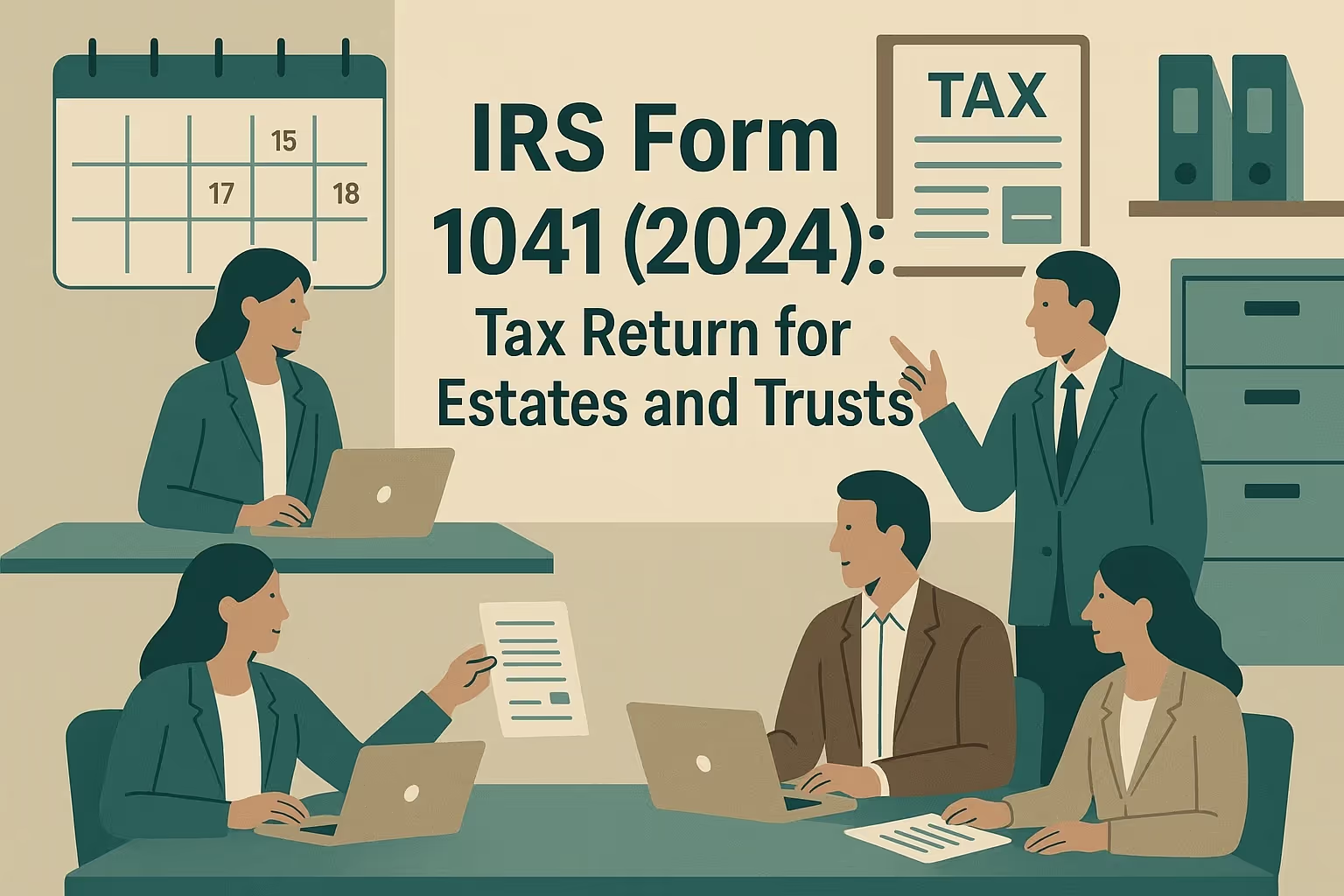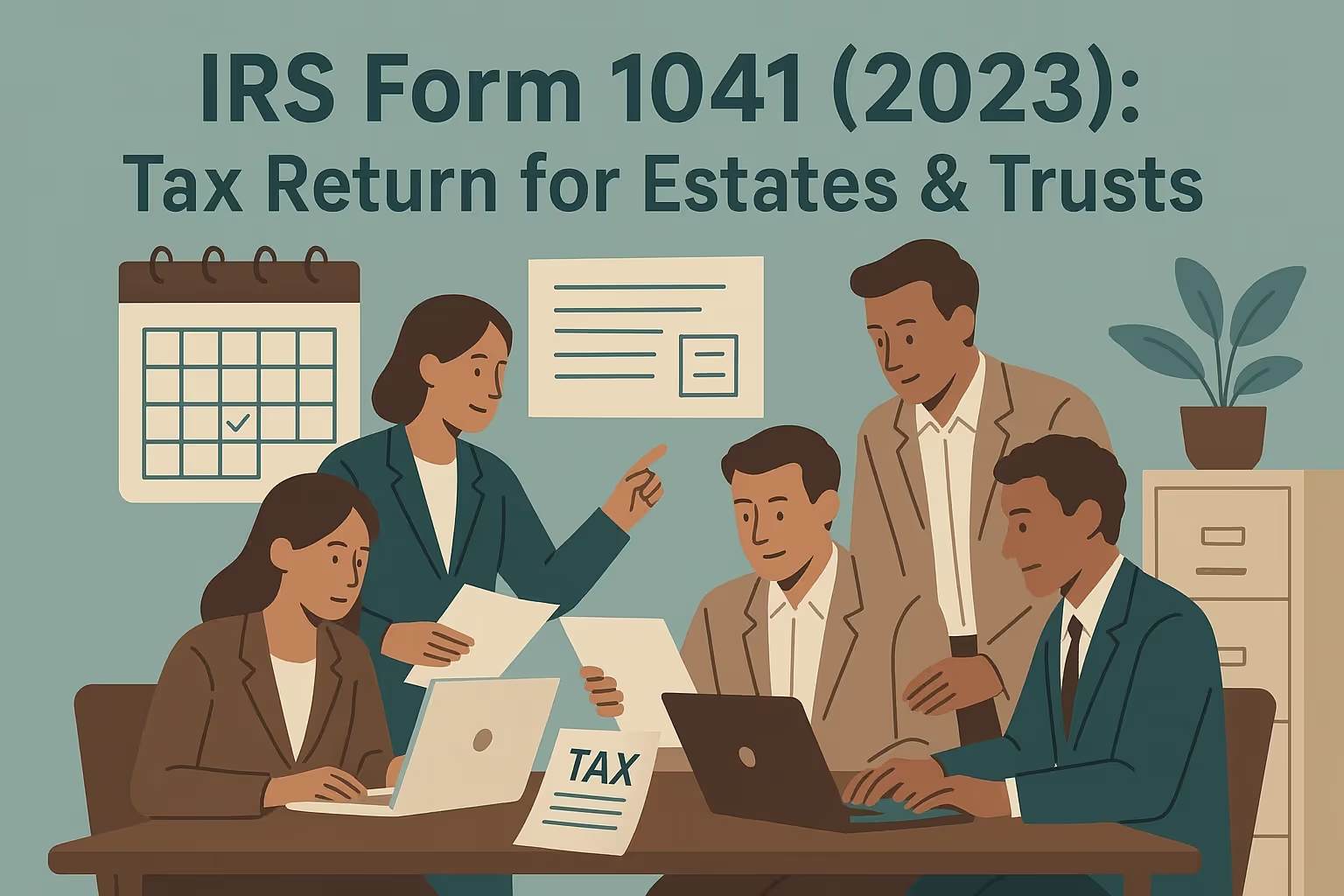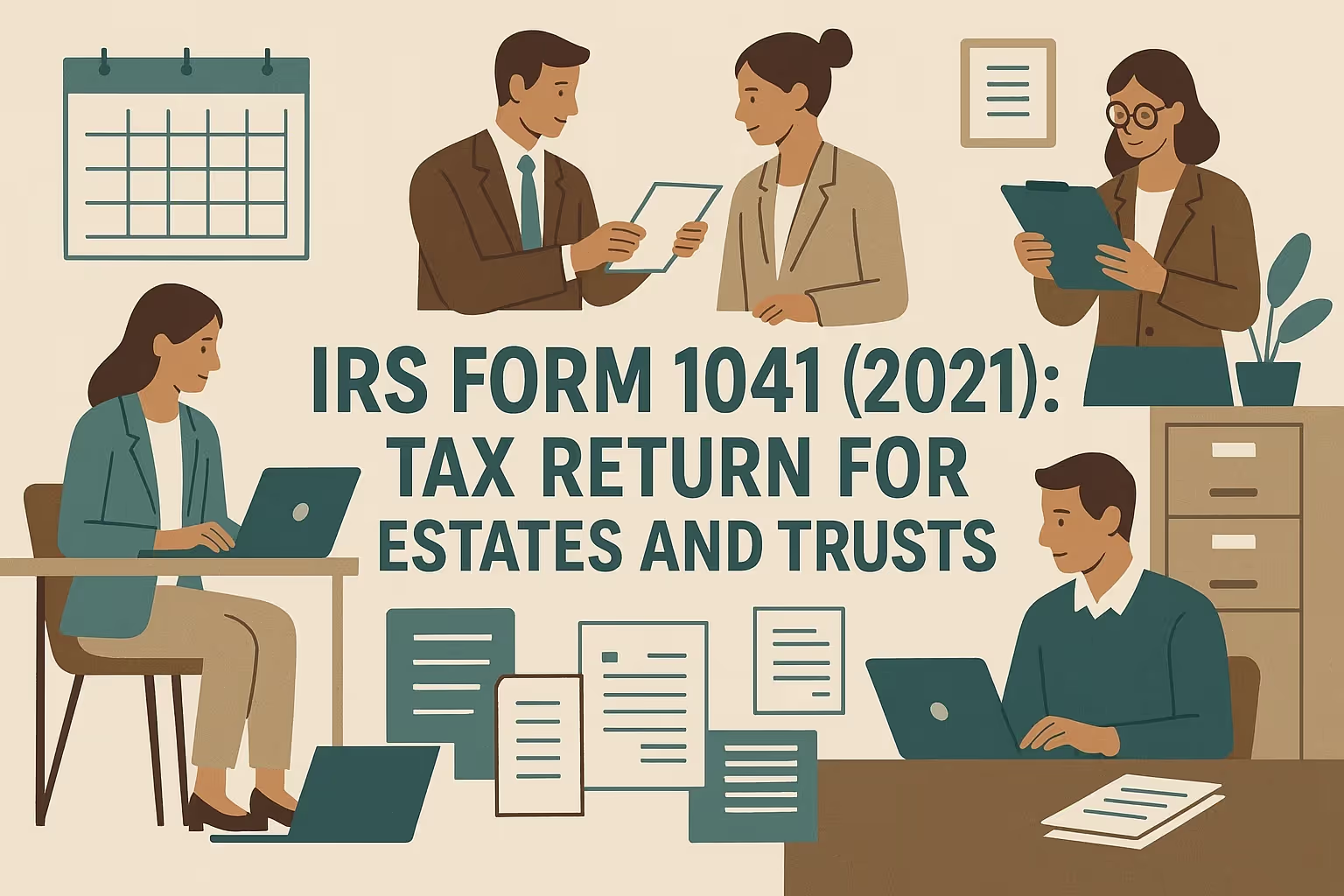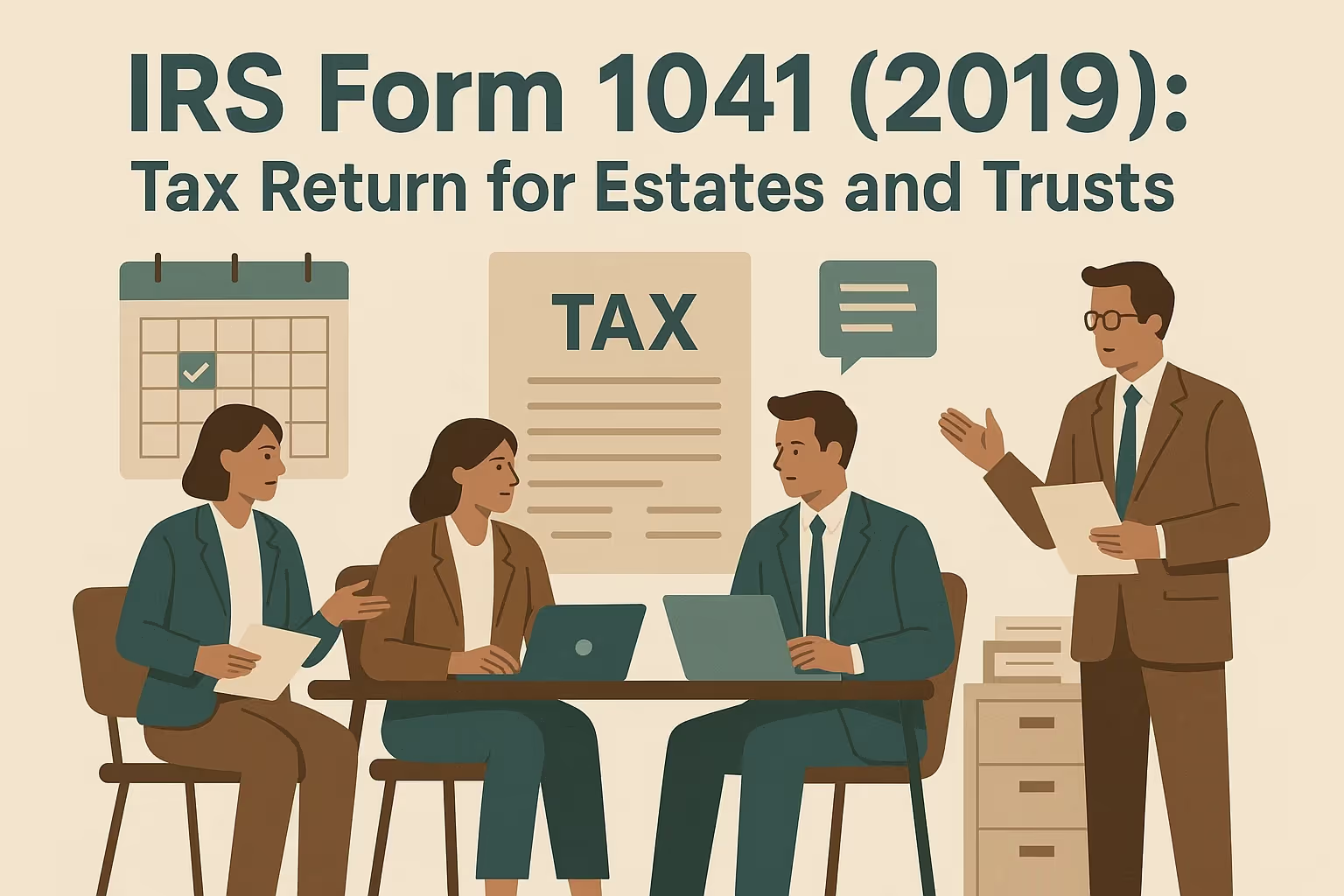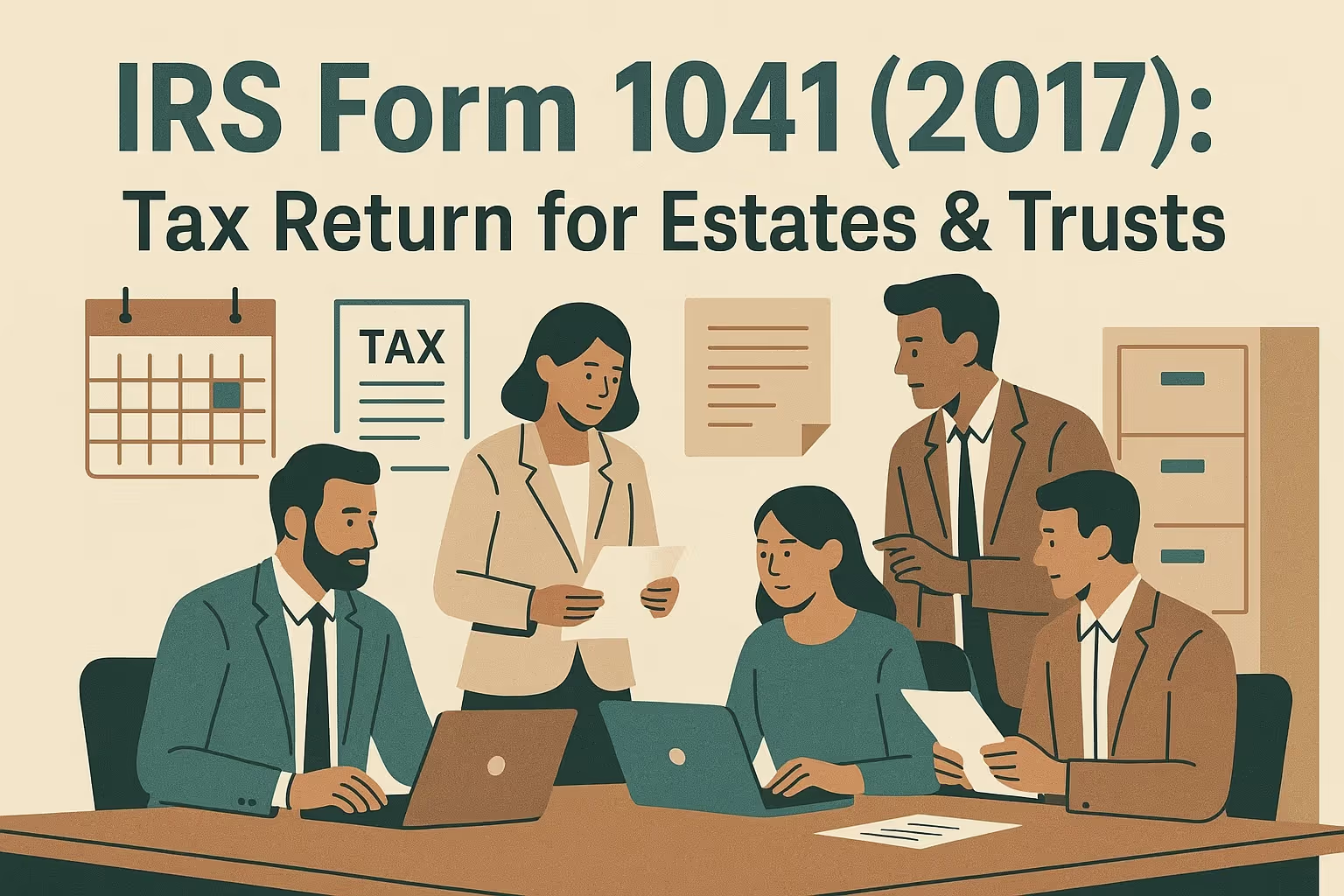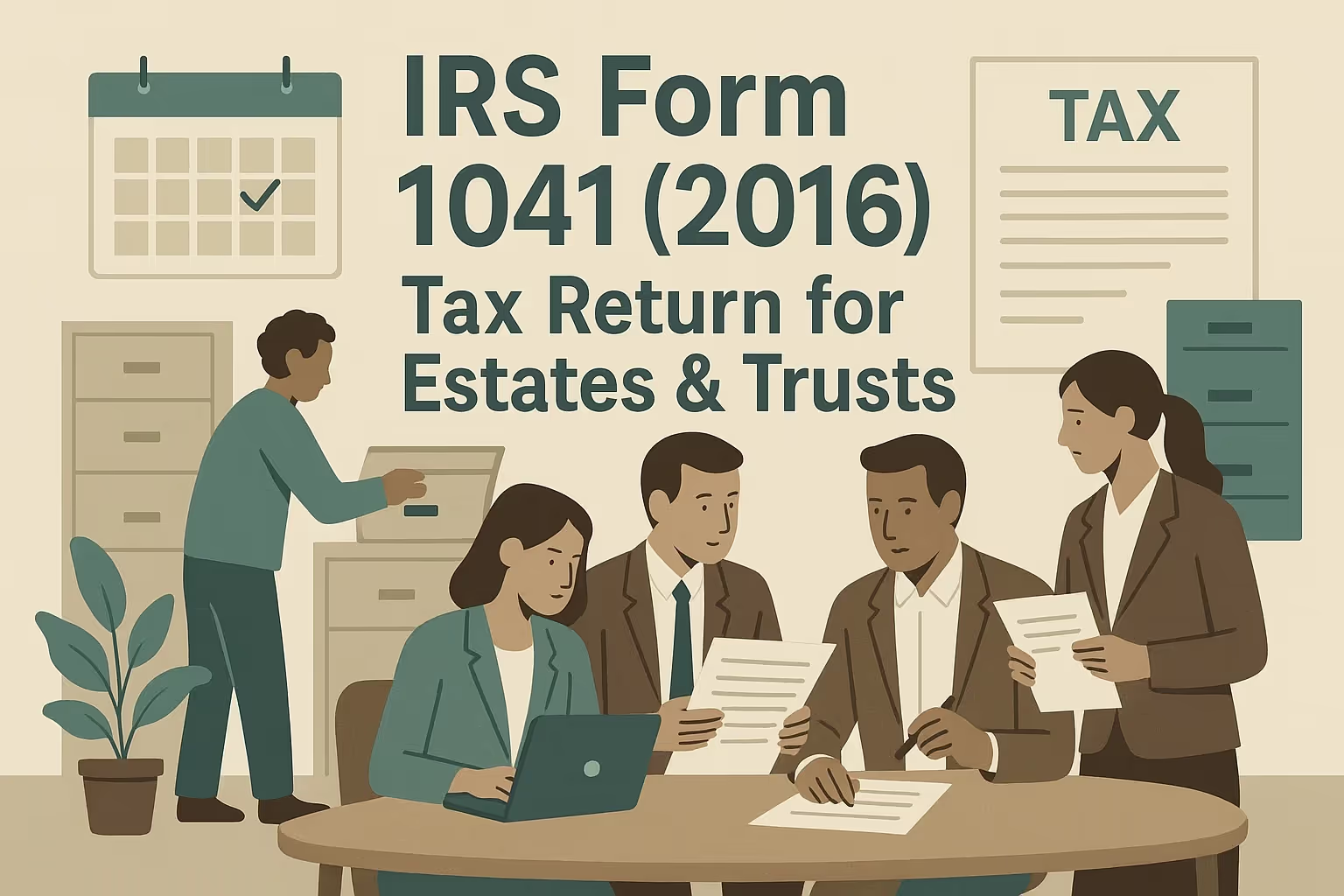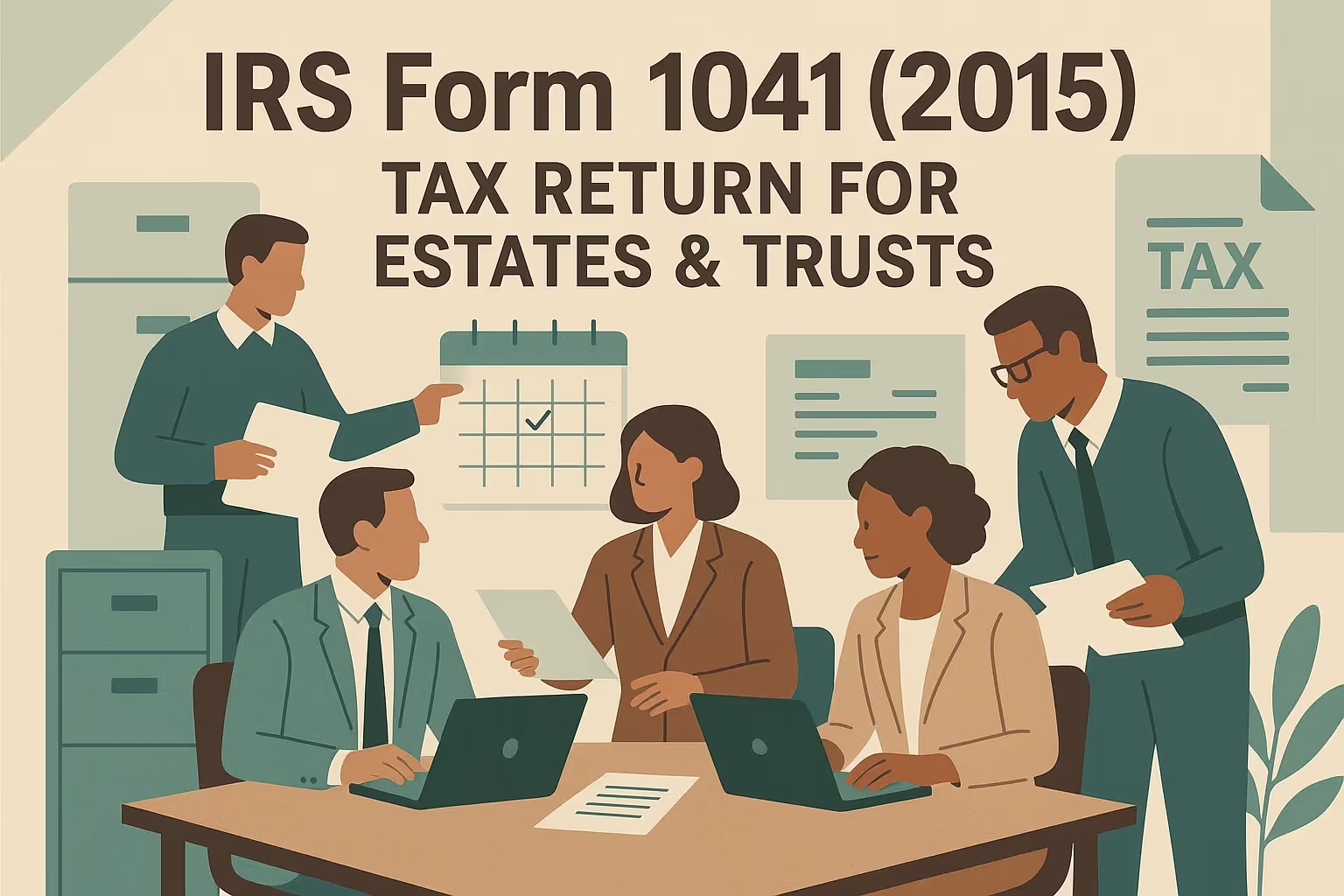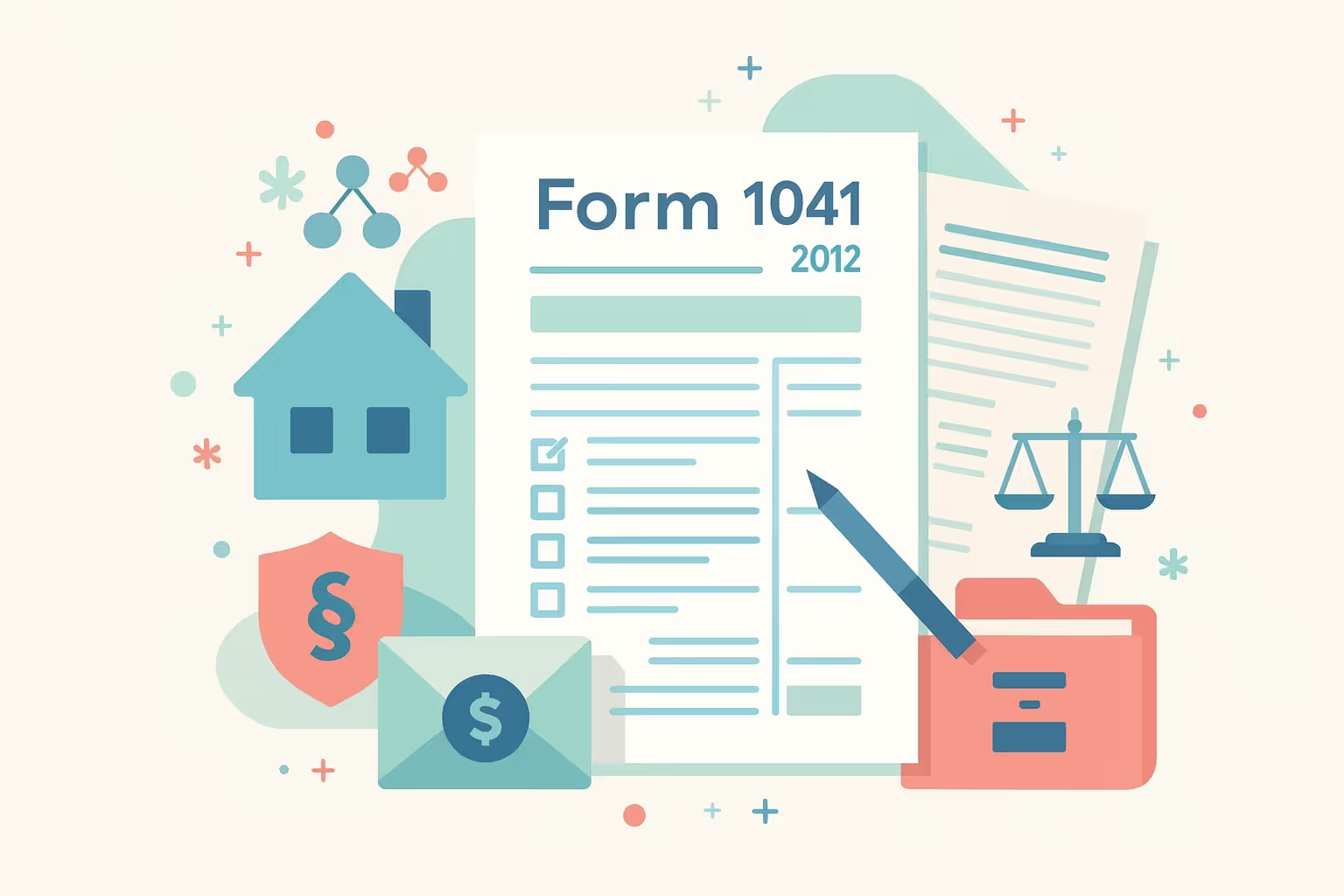Formulario 1041 (2014): Instrucciones para la presentación del impuesto sobre la renta del patrimonio
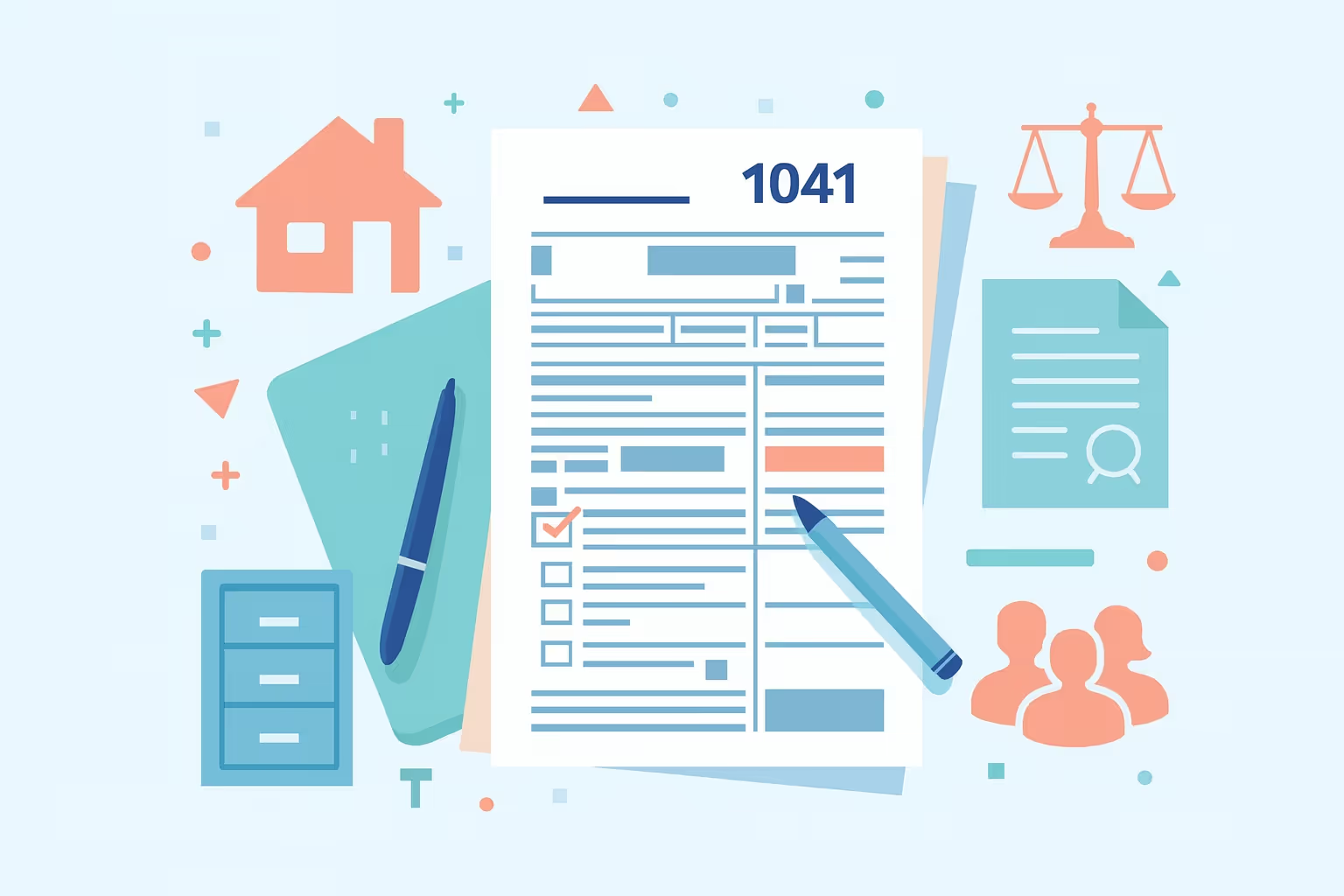
La presentación de una declaración fiduciaria de impuestos sobre la renta para un patrimonio o fideicomiso requiere el cumplimiento de las obligaciones tributarias federales sobre la renta y una comprensión clara de cómo se declaran los ingresos generados por los activos patrimoniales. El Servicio de Impuestos Internos exige que los fiduciarios, incluidos los representantes personales, albaceas o fideicomisarios, presenten el formulario 1041 cuando el patrimonio o el fideicomiso generan ingresos a través de inversiones, salarios pagados tras el fallecimiento de una persona fallecida u otros activos que generen ingresos. El formulario ayuda a determinar la obligación tributaria sobre la renta, la tasa impositiva aplicable y si la herencia paga impuestos en nombre de los beneficiarios.
El año tributario 2014 introdujo cambios significativos para los fiduciarios que administran las declaraciones de impuestos sobre el patrimonio. La presentación electrónica a través del sistema modernizado de presentación electrónica pasó a ser obligatoria, y cada patrimonio o fideicomiso debía tener un número de identificación patronal (EIN) único antes de su presentación. Estas actualizaciones mejoraron la precisión a la hora de declarar los ingresos brutos anuales, los ingresos netos distribuibles y los gastos deducibles, incluidos los gastos funerarios y administrativos. Entre las entidades cubiertas se incluyen las herencias de los difuntos, los fideicomisos otorgantes y los fideicomisos complejos que distribuyen los ingresos o los retienen para su asignación futura.
El Formulario 1041 de 2014, Declaración de impuestos sobre la renta de los Estados Unidos para sucesiones y fideicomisos, establece que los fiduciarios deben adjuntar anexos justificativos, declarar con precisión los ingresos obtenidos e identificar la participación de cada beneficiario. La preparación adecuada garantiza el cumplimiento del Código de Impuestos Internos y la presentación sin problemas de todos los formularios tributarios requeridos.
Comprensión de la declaración fiduciaria del impuesto sobre la renta
Los fiduciarios responsables de administrar sucesiones y fideicomisos deben presentar una declaración fiduciaria de impuestos sobre la renta cuando los ingresos de los activos patrimoniales alcancen los umbrales específicos establecidos por el Servicio de Impuestos Internos. El formulario 1041 se aplica al patrimonio o fideicomiso de un difunto que obtiene ingresos durante el año tributario a través de dividendos, intereses, operaciones comerciales o salarios pagados después del fallecimiento de una persona.
El requisito de presentación garantiza que el gobierno federal evalúe adecuadamente las obligaciones, los créditos y las deducciones del impuesto sobre la renta relacionados con los fines del impuesto federal sobre la renta. La presentación de informes precisos garantiza el cumplimiento del Código de Impuestos Internos y protege los intereses de los beneficiarios.
Las obligaciones de presentación surgen una vez que un patrimonio o fideicomiso genera un ingreso bruto anual de 600 dólares o más, tiene ingresos imponibles o incluye al menos un beneficiario no residente. La declaración se aplica a los fideicomisos residentes y no residentes, así como a las sucesiones que contienen activos que generan ingresos.
Los fiduciarios deben obtener un número de identificación del empleador antes de la presentación y usar este número de identificación del contribuyente para declarar todos los ingresos obtenidos durante la administración. Completar los formularios tributarios con precisión respalda el cálculo de los ingresos netos distribuibles, que determinan cuánto distribuye la entidad a los beneficiarios o retiene para ejercicios tributarios futuros.
Tipos de entidades que presentan el formulario 1041
- El patrimonio de un difunto se crea cuando una persona fallece. Reporta los ingresos obtenidos de los activos del patrimonio antes de su distribución completa a los herederos.
- Un fideicomiso simple debe distribuir los ingresos a los beneficiarios cada año y no puede solicitar deducciones caritativas.
- Un fideicomiso complejo puede acumular o distribuir ingresos según el criterio del fideicomisario y puede incluir créditos fiscales y deducciones variadas.
- Un fideicomiso otorgante está controlado por un otorgante que conserva ciertos poderes, lo que hace que los ingresos regresen a la declaración de impuestos sobre la renta personal del otorgante.
- Un fideicomiso de discapacidad calificado permite una cantidad de exención específica y apoya a las personas con discapacidades tal como se describe en el Código de Impuestos Internos.
Los fiduciarios deben hacer referencia a la Instrucciones de 2014 para el formulario 1041 y los anexos relacionados para garantizar que cada fuente de ingresos, deducción y asignación de beneficiarios se informe con precisión. El recurso del IRS detalla los cronogramas requeridos para las sucesiones y fideicomisos, las reglas de clasificación de los ingresos generados y las obligaciones de presentación de informes para cualquier relación fiduciaria extranjera.
Completar una declaración fiduciaria de impuestos sobre la renta requiere diligencia, documentación precisa y conocimiento de los umbrales de las tasas impositivas aplicables. Comprender estas reglas de presentación ayuda a cada patrimonio o fideicomiso a cumplir con los requisitos federales y a mantener la transparencia para todos los beneficiarios.
Actualizaciones del impuesto sobre el patrimonio y de la presentación de 2014
Los fiduciarios responsables de administrar sucesiones y fideicomisos deben mantenerse informados sobre las actualizaciones específicas de presentación introducidas durante el año tributario 2014. El Servicio de Impuestos Internos exigió adoptar nuevas medidas de cumplimiento que afectaran a la forma en que se preparaban y declaraban las declaraciones de impuestos sobre el patrimonio, las asignaciones de ingresos fiduciarios y las distribuciones imponibles.
La comprensión de estos cambios garantiza que cada representante personal, albacea o fideicomisario cumpla con sus obligaciones de presentación a efectos del impuesto federal sobre la renta y calcule correctamente la obligación tributaria sobre los ingresos obtenidos durante el período de administración.
Requisitos obligatorios de presentación electrónica
El año tributario 2014 implementó una regla de presentación electrónica obligatoria para todas las sucesiones y fideicomisos mediante el formulario 1041. Los fiduciarios debían presentar las declaraciones a través del sistema de presentación electrónica modernizado del IRS para reducir los errores y mejorar la precisión del procesamiento.
La presentación electrónica garantiza que los datos de la entidad, incluidos el número de identificación del empleador, los ingresos brutos anuales y el período de presentación de informes del año fiscal, se alineen con los estándares de cumplimiento del Código de Impuestos Internos. La presentación electrónica también permitió un acuse de recibo más rápido, lo que mejoró la rendición de cuentas cuando las sucesiones o los fideicomisos pagan el impuesto sobre la renta sobre los ingresos del trabajo.
Tasas impositivas y montos de exención actualizados
La estructura de tasas impositivas para sucesiones y fideicomisos en 2014 incluyó tramos progresivos que alcanzaron el 20 por ciento en los niveles de ingresos más altos. Los fiduciarios calculan los impuestos en función de los ingresos netos distribuibles, que establecen cuánto debe distribuir el patrimonio o fideicomiso a los beneficiarios o retener para reinvertirlo.
Los fideicomisos para discapacitados calificados son elegibles para una exención de 3.950 dólares, que apoya la administración de los activos generadores de ingresos mantenidos por personas con discapacidades. La declaración de cada entidad debe reflejar con precisión todos los créditos tributarios, las fuentes de ingresos y los límites de deducción al declarar los ingresos obtenidos durante el año fiscal.
Nuevos requisitos de presentación y firma de formularios
En 2014, el formulario 8453-F fue reemplazado por el formulario 8453-FE para las presentaciones electrónicas, lo que garantiza una autorización digital precisa de las declaraciones de impuestos fiduciarios sobre la renta. Cada declaración también requería una autorización para firmar el formulario 8879 por separado, lo que impedía que se presentaran varias declaraciones con una sola firma.
Estos cambios de procedimiento reforzaron la supervisión de la declaración de impuestos sobre la renta personal en nombre de personas fallecidas, fideicomisos irrevocables y otras entidades que posean propiedades o activos sujetos a impuestos. Los fiduciarios debían verificar que todos los cronogramas, anexos y formularios de autorización estuvieran alineados con el año fiscal correcto para garantizar su aceptación oportuna.
Los fiduciarios que entienden estas actualizaciones de presentación mantienen el cumplimiento, reducen el riesgo de rechazo de la declaración y se aseguran de que todos los activos patrimoniales y los ingresos del fideicomiso se declaren correctamente. La aplicación de estas reglas de 2014 promueve la presentación de informes tributarios precisos y cumple con los estándares federales para sucesiones y fideicomisos. El cumplimiento cuidadoso de estos requisitos permite a los fiduciarios cumplir con sus obligaciones legales y cumplir con su responsabilidad ante los beneficiarios.
Guía paso a paso para completar el formulario 1041 U.S.
Completar el formulario 1041, Declaración de impuestos sobre la renta de los Estados Unidos para sucesiones y fideicomisos, requiere una organización cuidadosa y un conocimiento del proceso de presentación de informes del Servicio de Impuestos Internos. Cada fiduciario debe seguir un enfoque estructurado para garantizar que todas las fuentes, deducciones y distribuciones de ingresos se ajusten a los propósitos del impuesto federal sobre la renta.
La presentación demuestra con precisión el cumplimiento del Código de Impuestos Internos y protege al fiduciario de las demoras o el rechazo de la declaración. Los pasos siguientes describen el proceso esencial para preparar una declaración fiduciaria de impuestos sobre la renta de acuerdo con los requisitos de 2014.
Paso 1. Reúna toda la documentación requerida
Los fiduciarios deben comenzar por recopilar documentos que verifiquen las actividades financieras del patrimonio o fideicomiso. Los registros obligatorios incluyen estados de cuenta bancarios, estados de ingresos, declaraciones de años anteriores y formularios como el 1099-INT para los intereses, el 1099-DIV para los dividendos y el 1099-MISC para los ingresos varios.
El fiduciario también debe obtener un número de identificación del empleador o un número de identificación del contribuyente para declarar todos los ingresos obtenidos por el patrimonio o el fideicomiso. En el caso del patrimonio de un difunto, la documentación adicional incluye el certificado de defunción y los registros de valoración de la propiedad de los activos que generan ingresos.
Paso 2. Verifique los requisitos de presentación
Un fiduciario debe confirmar si el patrimonio o el fideicomiso cumplen con los criterios para presentar la solicitud. Se requiere una declaración si el ingreso bruto anual es igual o superior a 600 dólares, si se incluye a un beneficiario no residente o si se declaran los ingresos imponibles. Las herencias con ingresos derivados de los salarios pagados, la actividad de alquiler o la venta de activos deben presentar una declaración federal de impuestos sobre la renta, incluso si no surge ninguna obligación tributaria. Los fideicomisos, incluidos los fideicomisos otorgantes y los fideicomisos complejos, siguen el mismo umbral.
Paso 3. Identificación completa de la entidad
La parte superior del formulario 1041 solicita detalles esenciales sobre el patrimonio o el fideicomiso. Los fiduciarios deben proporcionar el nombre legal, el número de identificación del empleador, la dirección y el tipo de entidad. Indique si la declaración representa una presentación inicial, una declaración enmendada o una declaración final. Incluya las fechas del año fiscal si presenta la declaración sobre la base de un año no calendario.
Paso 4. Reporte los ingresos generados
Todos los activos que generan ingresos deben declararse en las líneas correspondientes. Indique los ingresos por intereses, los dividendos, las ganancias de capital, los ingresos por alquileres y los ingresos comerciales. Si el patrimonio o fideicomiso opera una operación comercial o tiene propiedades que generan ingresos, adjunte anexos justificativos, como el Anexo D, para las ganancias y pérdidas. Indique en su totalidad todos los ingresos obtenidos de un fideicomiso extranjero o de inversiones extranjeras para mantener el cumplimiento.
Paso 5. Deduzca los gastos permitidos
Enumere las deducciones por costos administrativos, gastos funerarios, honorarios fiduciarios y contribuciones caritativas. Incluya los créditos tributarios disponibles para las actividades o los costos que reúnan los requisitos. Las deducciones reducen la base imponible y determinan los ingresos netos distribuibles, que reflejan la parte que los beneficiarios pueden recibir.
Paso 6. Determine los ingresos imponibles y aplique las tasas impositivas
Reste las deducciones totales del ingreso total para encontrar el ingreso total ajustado. Aplica las tasas impositivas sobre sucesiones y fideicomisos de 2014 para determinar la obligación tributaria sobre la renta. Asegúrese de que todos los formularios y anexos tributarios respalden las cifras declaradas.
Paso 7. Revise y adjunte los cronogramas requeridos
Adjunte todos los anexos aplicables, incluidos el Anexo A, el Anexo B y el Anexo G, así como los formularios del Anexo K-1 que muestren la participación de cada beneficiario. Cada anexo debe corresponder al período sobre el que se informa y al tipo de entidad.
Completar el formulario 1041 con precisión permite a los fiduciarios administrar con precisión las obligaciones de declaración de impuestos sobre el patrimonio, calcular las distribuciones correctamente y garantizar el pleno cumplimiento de los requisitos federales de presentación.
Seguir estos pasos garantiza que cada representante personal o fideicomisario informe con precisión todas las actividades imponibles del patrimonio o fideicomiso. El cumplimiento constante de estos procedimientos también contribuye a un registro preciso y a una coordinación fluida con los beneficiarios durante el proceso de presentación.
Presentación electrónica de formularios de impuestos sobre sucesiones o fideicomisos
La presentación de formularios de impuestos sobre sucesiones o fideicomisos mediante presentación electrónica se convirtió en un requisito para los fiduciarios a partir del año tributario de 2014. El Servicio de Impuestos Internos implementó este cambio para mejorar la precisión, reducir las demoras en el procesamiento y alinear la presentación de las declaraciones de impuestos fiduciarios sobre la renta con los propósitos del impuesto federal sobre la renta.
Cada representante personal, fideicomisario o albacea que administre una declaración de impuestos sobre el patrimonio debe asegurarse de que la entidad tenga un número de identificación del empleador antes de completar el proceso. La presentación electrónica también agiliza la presentación de informes sobre los ingresos brutos anuales, los créditos tributarios y las distribuciones para los beneficiarios residentes y no residentes.
El proceso de presentación electrónica requiere seleccionar un software aprobado por el IRS o trabajar con un proveedor autorizado que respalde las declaraciones fiduciarias. La presentación electrónica garantiza la coherencia de los datos, lo que ayuda a mantener el cumplimiento del Código de Impuestos Internos.
Los fiduciarios deben revisar todas las entradas antes de la transmisión para confirmar que cada fuente de ingresos, deducción y distribución esté clasificada correctamente. Cuando el patrimonio o el fideicomiso requieren más tiempo, se puede obtener una prórroga automática mediante el formulario 7004, que otorga cinco meses adicionales para presentar la declaración de impuestos federales sobre la renta.
- Presentación única: Cada patrimonio o fideicomiso debe presentar su propia declaración con un número de identificación del empleador por separado. No se permite combinar entidades en una sola presentación.
- Autorización de firma: El formulario 8879-F debe firmarse en cada declaración de impuestos fiduciarios sobre la renta para validar la presentación.
- Documentación de respaldo: Adjunte anexos como el Anexo B para los ingresos netos distribuibles y el Anexo K-1 para la participación de cada beneficiario.
- Declaración modificada: Si se producen errores después de la presentación, presente una declaración corregida mediante el formulario 1041-X para informar los ajustes.
- Recibo de confirmación: Conserve el acuse de recibo del IRS confirmando la aceptación de la presentación electrónica.
- Software autorizado: Utilice únicamente los programas que figuran en la lista de proveedores de archivos electrónicos aprobados por el IRS para garantizar una transmisión de datos segura y precisa.
La presentación electrónica ayuda a los fiduciarios a evitar errores de presentación comunes, como números de identificación que no coinciden o archivos adjuntos faltantes. También garantiza el cumplimiento de los plazos establecidos en el Código de Impuestos Internos y reduce los riesgos asociados con las presentaciones manuales. Los fiduciarios deben mantener registros digitales de todos los documentos transmitidos, incluidos los cronogramas y los recibos de confirmación, durante un mínimo de tres años.
La presentación correcta de una declaración fiduciaria electrónica de impuestos sobre la renta apoya la transparencia, garantiza que cada patrimonio pague la cantidad correcta de impuestos y demuestra la responsabilidad en el manejo de los activos patrimoniales. La adopción de prácticas de presentación electrónica también refuerza la precisión en las múltiples presentaciones y simplifica las futuras obligaciones de presentación de informes.
Pago del impuesto sobre la renta y las obligaciones estimadas
Los fiduciarios que administran sucesiones y fideicomisos deben cumplir con las obligaciones de pago asociadas con la presentación de una declaración federal de impuestos sobre la renta. Cada patrimonio o fideicomiso debe pagar impuestos sobre los ingresos generados durante el año tributario, según los ingresos imponibles y los tramos de tasas impositivas aplicables. El momento adecuado de los pagos y el mantenimiento de registros garantizan el pleno cumplimiento del Código de Impuestos Internos. Los fiduciarios también deben asignar con precisión los impuestos estimados a los beneficiarios y asegurarse de que los pagos reflejen los ingresos obtenidos durante el año fiscal.
Fecha límite de pago
La fecha límite para la presentación y el pago es el 15 de abril de 2015, para las entidades del año calendario, o el día 15 del cuarto mes siguiente al final del año fiscal. El cumplimiento de este plazo garantiza que el patrimonio o el fideicomiso paguen los impuestos con prontitud y evita que se acumulen intereses sobre los saldos pendientes de pago. La presentación oportuna demuestra la administración responsable de los activos patrimoniales y el cumplimiento de las normas federales del impuesto sobre la renta.
Métodos de pago
- Sistema electrónico de pago de impuestos federales (EFTPS): Esta plataforma segura en línea permite a los fiduciarios programar y transmitir los pagos del impuesto federal sobre la renta directamente al Servicio de Impuestos Internos. Los pagos se pueden planificar emitiendo números de confirmación para cada transacción.
- Débito directo: Los fiduciarios pueden autorizar el pago durante la presentación electrónica, seleccionando una fecha de retiro específica dentro del período de presentación. Este método permite un seguimiento eficiente de los pagos y minimiza las demoras administrativas.
- Cheque o giro postal: Para las entidades que utilizan la presentación en papel, los pagos deben hacerse a nombre del Tesoro de los Estados Unidos. El número de identificación del empleador, el año tributario y el «formulario 1041» deben aparecer en la línea de notas para que la acreditación sea adecuada.
Requisitos tributarios estimados
Los fiduciarios deben realizar pagos estimados trimestrales si el total de impuestos adeudados supera los $1,000 después de los créditos. Los pagos se basan en el 90 por ciento del impuesto del año en curso o el 100 por ciento del pasivo del año anterior. Las cuotas trimestrales vencen el 15 de abril, el 16 de junio, el 15 de septiembre y el 15 de enero del año siguiente. El cumplimiento de estos plazos evita el pago insuficiente de los intereses y garantiza el cumplimiento de los requisitos de presentación de informes anuales sobre los ingresos brutos.
Asignación de pagos estimados
Las herencias y fideicomisos que distribuyen los pagos estimados a los beneficiarios deben presentar una declaración Formulario 1041-T, Asignación de pagos de impuestos estimados (2014). El formulario autoriza las transferencias de créditos tributarios a los beneficiarios, garantizando que la participación de cada beneficiario se alinee con sus ingresos netos distribuibles declarados. La asignación adecuada garantiza que los beneficiarios reciban la documentación precisa para sus declaraciones de impuestos sobre la renta personal.
Comprender cómo administrar las responsabilidades de pago de sucesiones o fideicomisos promueve la precisión, la responsabilidad y el cumplimiento. Los fiduciarios que cumplen con estos requisitos mantienen el control sobre los informes financieros, respaldan la distribución adecuada de los beneficiarios y respetan las normas federales de presentación de impuestos.
Las prácticas de pago consistentes también protegen el patrimonio o el fideicomiso de cargos por intereses innecesarios y complicaciones administrativas. El mantenimiento de registros de pago precisos garantiza la transparencia con los beneficiarios y prepara al fiduciario para posibles auditorías o revisiones. La implementación de un enfoque estructurado para el pago de impuestos refuerza la responsabilidad del fiduciario de administrar los activos patrimoniales de manera responsable y cumplir con todas las obligaciones tributarias federales sobre la renta.
Cronogramas requeridos para sucesiones y fideicomisos
Los fiduciarios que preparen una declaración de impuestos federales sobre la renta para un patrimonio o fideicomiso deben adjuntar los anexos correctos para declarar los ingresos, las deducciones y las distribuciones con precisión. Cada lista tiene un propósito distinto: garantizar que cada fuente de ingresos, crédito tributario y asignación de beneficiarios cumpla con el Código de Impuestos Internos.
Adjuntar los cronogramas requeridos respalda la presentación de informes financieros transparentes, lo que permite al Servicio de Impuestos Internos evaluar los ingresos generados y verificar cómo el patrimonio o fideicomiso paga los impuestos en todas sus actividades.
Horarios obligatorios
- Anexo A, Deducciones caritativas: Reporta las contribuciones hechas a partir de los ingresos brutos de sucesiones o fideicomisos complejos. Las deducciones deben cumplir con los requisitos federales y estar respaldadas con recibos o documentación.
- Anexo B, Deducción por distribución de ingresos: Calcula el ingreso neto distribuible y la cantidad asignada a los beneficiarios. La deducción afecta directamente a la parte imponible retenida en el patrimonio o fideicomiso.
- Anexo G, Cálculo de impuestos: Resume la obligación tributaria total, incluidos los créditos y otros ajustes. La finalización garantiza una determinación precisa de las obligaciones tributarias sobre la renta a efectos del impuesto federal sobre la renta.
- Anexo J, Distribución de la acumulación: Se aplica cuando los ingresos no distribuidos de años anteriores se pagan a los beneficiarios. El cronograma proporciona transparencia para la planificación de la distribución multianual y los cálculos de las tasas impositivas.
Cronogramas y formularios de apoyo
- Anexo D (formulario 1041), Ganancias y pérdidas de capital: Reporta las ganancias o pérdidas por la venta de propiedades, valores u otros activos generadores de ingresos mantenidos por el patrimonio o el fideicomiso.
- Anexo I (formulario 1041), Impuesto mínimo alternativo: Calcula las obligaciones tributarias adicionales cuando los ingresos superan los umbrales establecidos, lo que garantiza el cumplimiento adecuado de las normas impositivas mínimas alternativas.
- Anexo K-1 (formulario 1041), participación del beneficiario: Enumera los ingresos, las deducciones y los créditos de cada beneficiario. Una preparación precisa garantiza que cada destinatario informe cifras consistentes en su declaración de impuestos sobre la renta personal.
- Formulario 4952, Deducción de gastos por intereses de inversión: Se aplica cuando el patrimonio o el fideicomiso incurren en gastos por intereses relacionados con las actividades de inversión.
- Formulario 8960, Impuesto sobre la renta neta de inversiones: Reporta los impuestos adicionales adeudados cuando los ingresos netos por inversiones superan los umbrales federales para sucesiones y fideicomisos.
Cada lista debe alinearse con las actividades del patrimonio o fideicomiso durante el año tributario y coincidir con el tipo de entidad declarante, ya sea el patrimonio de un difunto, un fideicomiso otorgante o un fideicomiso complejo. La inclusión precisa garantiza el cumplimiento, reduce los errores de presentación y refuerza la responsabilidad del fiduciario en la administración de los activos patrimoniales de acuerdo con las directrices federales. La organización adecuada de las listas también promueve la transparencia para los beneficiarios y la presentación de informes coherentes en todos los formularios tributarios relacionados.
Errores comunes al presentar un impuesto sobre la renta fiduciario
La presentación de una declaración fiduciaria de impuestos sobre la renta para sucesiones y fideicomisos requiere precisión, documentación exhaustiva y una comprensión completa de todas las obligaciones de presentación de informes. Los errores durante la preparación pueden provocar que se rechacen las solicitudes, que las asignaciones de los beneficiarios sean inexactas o que se envíe correspondencia adicional al Servicio de Impuestos Internos. Reconocer los errores frecuentes ayuda a los fiduciarios a reforzar el cumplimiento de los impuestos federales sobre la renta y a evitar interrupciones en la administración de sucesiones o fideicomisos.
Presentación con una identificación incorrecta
Uno de los errores más frecuentes implica usar el número de seguro social del difunto en lugar de obtener un número de identificación del empleador. Cada patrimonio o fideicomiso debe operar con su propio número de identificación fiscal para declarar los ingresos obtenidos de sus activos. El uso de un identificador incorrecto puede provocar que los registros no coincidan y que se retrase el procesamiento de la declaración federal de impuestos sobre la renta. Los fiduciarios deben solicitar el número correcto antes de preparar cualquier formulario tributario requerido.
Informar erróneamente las acciones de los beneficiarios
La asignación incorrecta de los ingresos netos distribuibles entre los beneficiarios puede distorsionar las declaraciones de impuestos sobre la renta personal y crear inconsistencias en las ganancias declaradas. La participación de cada beneficiario debe coincidir con las cifras reportadas en el Anexo K-1.
Las sucesiones o fideicomisos con dos o más beneficiarios, beneficiarios no residentes o relaciones fiduciarias extranjeras deben garantizar que sus informes reflejen con precisión los derechos y la obligación tributaria de cada parte. Los cálculos adecuados protegen la transparencia y preservan una contabilidad precisa en todas las entidades.
Faltan fechas límite o cronogramas requeridos
No cumplir con la fecha límite de presentación u omitir los cronogramas necesarios puede causar complicaciones de cumplimiento. Cada declaración fiduciaria de impuestos sobre la renta debe incluir todos los anexos aplicables, como el Anexo B y el Anexo G, así como los formularios de respaldo para los créditos o deducciones fiscales. Las presentaciones tardías pueden generar intereses sobre los montos impagos o complicar la presentación de informes de distribución para la declaración final. Una organización cuidadosa garantiza que toda la documentación se ajuste a los requisitos federales de presentación.
Evitar estos errores ayuda a los fiduciarios a administrar las obligaciones de declaración de impuestos sobre el patrimonio de manera efectiva y a mantener la confianza con los beneficiarios. Revisar cada entrada para comprobar su exactitud, validar la identificación de la entidad y confirmar que se han incluido todos los documentos adjuntos necesarios son pasos clave en una administración responsable. La presentación precisa respalda el cumplimiento del Código de Impuestos Internos, mejora la transparencia y garantiza que el patrimonio o el fideicomiso cumplan correctamente con sus obligaciones financieras.
Preguntas frecuentes
¿Qué desencadena el requisito de presentación del patrimonio de un difunto?
El patrimonio de un difunto debe presentar una declaración fiduciaria de impuestos sobre la renta cuando gane 600 dólares o más en ingresos brutos anuales, tenga algún ingreso sujeto a impuestos o incluya a un beneficiario que sea un extranjero no residente. El patrimonio genera ingresos a partir de fuentes como los salarios pagados después del fallecimiento, los intereses de inversión o las actividades de alquiler. La presentación del formulario 1041 garantiza que todos los ingresos obtenidos durante la administración se declaren con precisión y se graven de acuerdo con las normas del impuesto federal sobre la renta.
¿Cómo genera ingresos una herencia durante la administración?
Un patrimonio genera ingresos a través de múltiples fuentes, incluidos dividendos, ganancias de capital, intereses, alquileres y ganancias comerciales vinculadas a los activos patrimoniales. Cada fuente debe declararse en la declaración fiduciaria de impuestos sobre la renta para calcular el ingreso imponible total. Cuando el patrimonio de un difunto continúa operando negocios o manteniendo inversiones, el fiduciario debe hacer un seguimiento de los ingresos obtenidos y presentar los cronogramas correspondientes para garantizar el cumplimiento del Código de Impuestos Internos.
¿Cuáles son las reglas de presentación de un fideicomiso otorgante?
Un fideicomiso del otorgante existe cuando el otorgante conserva ciertos poderes sobre los activos o ingresos del fideicomiso. En estos casos, todos los ingresos generados por el fideicomiso se declaran directamente en la declaración de impuestos sobre la renta personal del otorgante, en lugar de que el fideicomiso se presente de forma independiente. El fiduciario aún debe mantener registros y garantizar que la presentación de informes sea precisa a los efectos del impuesto federal sobre la renta. El fideicomiso permanece transparente a los efectos de la declaración de impuestos mientras los poderes del otorgante permanezcan activos.
¿Por qué un patrimonio o fideicomiso necesita un número de identificación del empleador?
El número de identificación del empleador sirve como identificación oficial del contribuyente para un patrimonio o fideicomiso. Distingue a la entidad del difunto o del otorgante y permite informar adecuadamente de los ingresos generados durante el período de administración. Los fiduciarios utilizan este número para presentar el formulario 1041, emitir los anexos K-1 y realizar los pagos de impuestos estimados. Sin un número de identificación patronal válido, el Servicio de Impuestos Internos no puede procesar la declaración con precisión.
¿En qué se diferencia un fideicomiso complejo de un fideicomiso simple?
Un fideicomiso complejo puede acumular o distribuir ingresos a discreción del fideicomisario, mientras que un fideicomiso simple debe distribuir todos los ingresos anualmente. Como un fideicomiso complejo conserva un mayor control, puede solicitar deducciones por contribuciones caritativas y asignar los ingresos entre varios beneficiarios. El fiduciario debe hacer un seguimiento de la forma en que el fideicomiso genera ingresos y aplicar las distribuciones para garantizar un tratamiento tributario adecuado. Cada presentación refleja cómo las ganancias retenidas afectan los ingresos imponibles.
¿Qué pasa si un extranjero no residente es beneficiario del patrimonio o fideicomiso?
Si el beneficiario es un extranjero no residente, el fiduciario debe declarar su parte de los ingresos por separado en el Anexo K-1 y retener los impuestos federales requeridos. El beneficiario no residente puede estar sujeto a normas tributarias específicas según el tipo de ingreso generado. Las obligaciones de presentación de informes garantizan el cumplimiento del Código de Impuestos Internos y la asignación adecuada de la deuda tributaria entre los participantes estadounidenses y extranjeros en el patrimonio o fideicomiso.
¿Cómo deben gestionar los fiduciarios los ingresos obtenidos después de la muerte del difunto?
Los ingresos obtenidos después de la muerte pertenecen al patrimonio del difunto y deben declararse en el formulario 1041. Los ejemplos incluyen los dividendos, los salarios pagados y los ingresos por intereses recibidos después de la fecha del fallecimiento. El fiduciario considera estos ingresos al calcular los ingresos netos distribuibles y determinar los montos distribuidos a los beneficiarios. La presentación de informes adecuada garantiza la transparencia y confirma que todos los ingresos generados por los activos patrimoniales se gravan de acuerdo con los requisitos federales.






